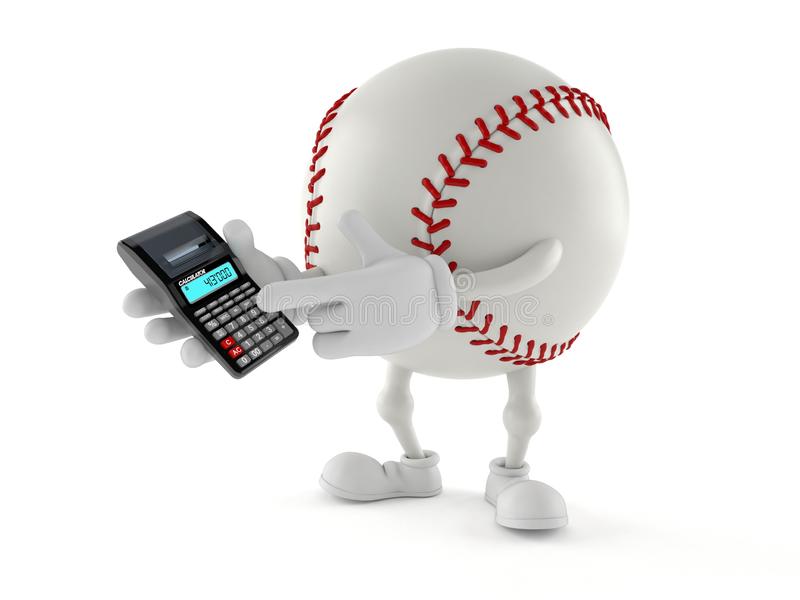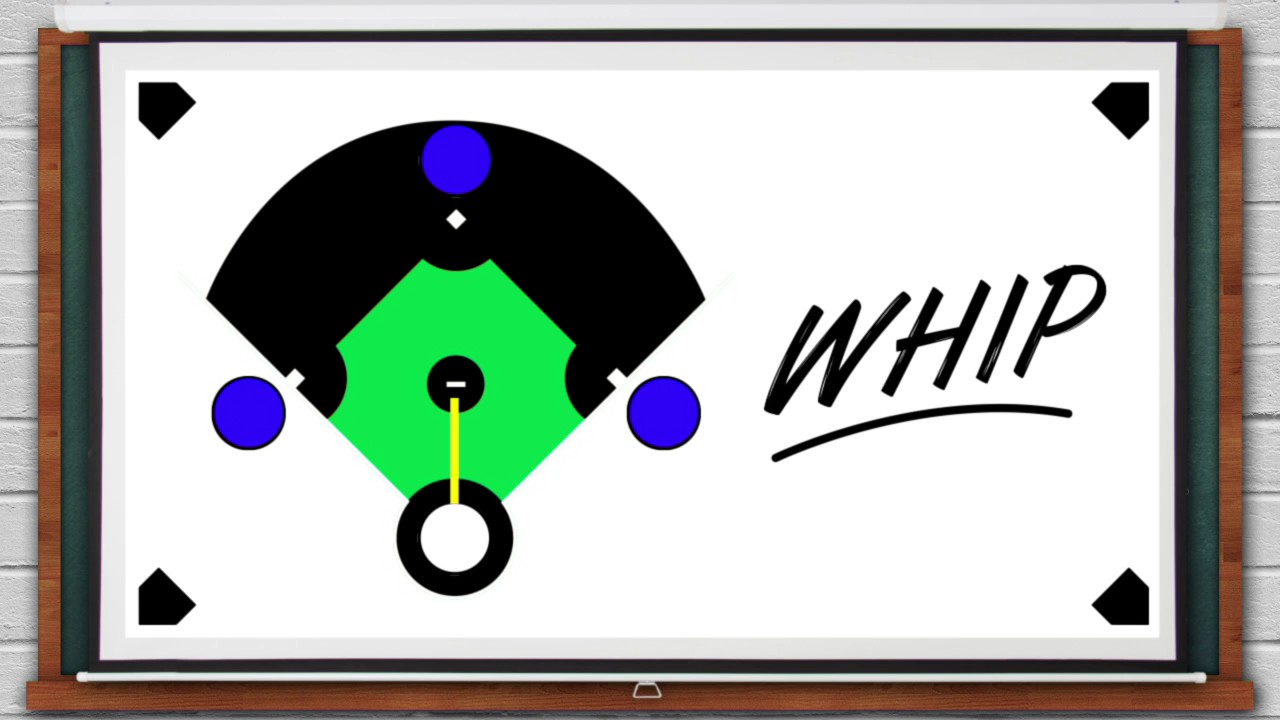If you watch a Major League Baseball game or play fantasy baseball, you’ve probably seen the statistic “WHIP”. But what does WHIP mean? What is WHIP in Baseball? Yeah, there is a bullpen in baseball too, so does WHIP have anything to do with the bullpen?
Is it a bull whip? Not quite…well not even close.
What is WHIP in Baseball?
WHIP = Walks + Hits / Innings Pitched. Thus, W-H-I-P is the acronym and is becoming one of the most popular pitching statistics.
What is the best way to understand WHIP in Baseball?
What WHIP means is how many walks plus hits did a pitcher allow per total innings pitched ratio on average.
This is to show many baserunners a pitcher allowed on his own.
Meaning the exclusion of baserunners via error, hit by pitch, catcher’s interference, or strike 3-passed balls when a runner reaches base.
WHIP is simply used just to calculate the total number of hits plus walks per inning by a pitcher.
Why Does a Pitcher’s WHIP matter?
Walks and hits are solely allowed by a pitcher whereas errors for example are allowing a batter to reach base due to a mistake by the defense. Which would not be the pitcher’s fault.
WHIP is a common statistic used when looking at how good a pitcher really is because it only counts things a pitcher can control.
For example, a pitcher can’t control an error by a fielder and thus should not count against a pitcher’s performance stats.
It’s also one of the most commonly used stats in fantasy baseball because of the same reason.
Because it is only counting stats a pitcher can control. True baseball fans know that stats such as wins aren’t the best way to review how good a pitcher really is.
How to calculate WHIP?
The formula to calculate WHIP is simple. Walks + Hits per Innings Pitched ratio. That’s walks plus hits divided by inning pitched. That’s it.
Let’s look at some examples of pitching lines from game outings and then calculate a pitcher’s WHIP:
Very simple, right? Just add Hits and Walks then divide that number by the total number of innings pitched.
You do the exact same formula and format if you want to calculate one pitcher’s WHIP over the course of a season.
The easiest way to do this, if it’s not already done for you, is look at major league baseball game-by-game logs.
Example of Corbin Burnes 2021 regular-season game log – calculating a pitcher’s WHIP:
WHIP = Walks + Hits / Innings Pitched
What is a good WHIP in baseball?
Now that you know what WHIP is and how to calculate it, you probably want to know what it all means. What is a good WHIP? What is a bad WHIP? Average WHIP?
There isn’t an exact line to draw in the sand when it comes to WHIP as far as what is good versus what isn’t. It’s semi vague, but the general rule of thumb is as follows:
- Under 1.00 = Elite, Outstanding Pitcher’s Performance
- 1.00 – 1.25 = Great, above average
- 1.25 – 1.50 = Average
- 1.50 and above = Bad, below average
When pitchers complete a full season and have a WHIP around 1.00 and below, that is elite status. Worthy of Cy Young consideration.
Most of the time if a pitcher has a low WHIP, they also most likely have a low ERA.
Which would result in a very successful season. Wins and Losses don’t really matter here as that stat is somewhat meaningless because there are so many outside factors.
Whereas WHIP is simple because it’s only what the pitcher does.
What is the League average WHIP?
| Year | WHIP |
| 2022 | 1.24 |
| 2021 | 1.29 |
| 2020 | 1.32 |
| 2019 | 1.33 |
| 2018 | 1.30 |
| 2017 | 1.34 |
| 2016 | 1.32 |
The league average WHIP has improved slightly over the last few years.
Over the last couple of seasons, the Major League Average WHIP has dropped down into the 1.2 range from the 1.3 range where it was the previous handful of years.
Pitching training methods have improved significantly over the last 10 years and pitcher’s effectiveness has drastically improved while the amount of inning pitched is decreasing per pitcher due to the number of pitchers being used in each game..
Pitchers are stronger and throwing harder than ever and pitching stats are getting better as a result.
Does a good WHIP always indicate a low ERA?
Pitchers that have a higher ERA than expected when having a low WHIP is a result of giving up big hits. Big hits such as extra base hits and home runs.
Think about it, if a pitcher has a 1.00 WHIP but a 3.00 ERA, how did 3 runs score on average?
Especially if they only give up 1 hit or walk per inning?
That’s because those 3 runs per game were probably scored off homeruns, meaning “big hits”.
Typically, a situation like that is an outlier.
Most pitcher with WHIPs around 1.00 have ERA’s in the 2.00 – 2.50 range, which is an outstanding whip stat.
A good ERA in baseball is between 2.00 and 3.00. And a good WHIP stat in baseball is between 1.00 and 1.25.
Who has the lowest WHIP in MLB?
Many of the best pitchers of all time are on the list of pitchers with the lowest WHIPs.
Below is a list of the lowest WHIPs by pitchers with at least 1000 career innings pitched:
What about single-season WHIP leaders?
The lowest WHIP stat of all time for a single season belongs to Hall of Fame Pitcher Pedro Martinez. One of my favorite pitchers of all time.
In 2000, Pedro Martinez produced an astonishingly low WHIP of 0.74! And that’s with 217 innings pitched!
Here is a short list of single season WHIP stat leaders of all-time:
- 2000 – Pedro Martinez = 74 WHIP
- 1913 – Walter Johnson = .78 WHIP
- 2019 – Justin Verlander = .80 WHIP
- 1908 – Addie Ross = .81 WHIP
- 1995 – Greg Maddux = .81 WHIP
- 1910 – Ed Walsh = .82 WHIP
- 1908 – Christy Mathewson = .83 WHIP
- 1909 – Christy Mathewson = .83 WHIP
- 1880 – George Bradley = .83 WHIP
- 1908 – Mordecai Brown = .84 WHIP
Personally, I’m not a fan of including stats from the early 1900’s, let alone the 1800’s.
I think within the last 75 years is a better gauge.
To me, the best WHIPs of all time for a single season belong to just a handful of the game’s top pitchers: Pedro Martinez, Justin Verlander and Greg Maddux.
Along with names not on the list above such as Zach Greinke in 2015 (.84 WHIP), Bob Gibson in 1968 (.85 WHIP), Sandy Koufax in 1965 (.86 WHIP), and Clayton Kershaw in 2014 (.86 WHIP).
Max Scherzer also deserves a shout-out with his .86 WHIP in 2021!
Why is WHIP important?
The reason WHIP is important and commonly used is that it measures only what the pitcher accounts for himself.
It measures what the pitcher gave up on their own rather than including errors and other factors that lead to base runners.
It shows exactly what the pitcher gave up in terms of baserunners.
Obviously, the fewer baserunners the fewer runs are scored.
There’s just one thing I don’t like about WHIP; that it doesn’t include Hit By Pitch (HBP).
Hit batters are a direct result of the pitcher just as walks and hits are. I often wonder if it was left out simply to have the ability to use the Acronym “WHIP”.
Because it could just as easily be “HWIP” for hits + walks per innings pitched. But why is hit by pitch left off when it’s a direct result of the pitcher?
No other player is responsible for a hit batter. It’s the same as a walk or hit that a pitcher gives up because only the pitcher was the cause of it. It’s a mystery to me and in my opinion, should be included. WHHBPIP…not the same ring to it. In fantasy baseball, WHIP is a key metric that top fantasy players use to determine where to draft a pitcher.
| Player | Career WHIP | Career Achievements |
|---|---|---|
| Addie Joss | 0.97 | Joss played for the Cleveland Naps from 1902-1910 and had a career WHIP of 0.97. He is one of only eight pitchers in MLB history to have a career WHIP under 1.00. Joss was a three-time ERA leader and was elected to the Baseball Hall of Fame in 1978. |
| Ed Walsh | 1.00 | Walsh played for the Chicago White Sox from 1904-1917 and had a career WHIP of 1.00. He is another member of the exclusive club of pitchers with a career WHIP under 1.00. Walsh was a two-time ERA leader and was elected to the Baseball Hall of Fame in 1946. |
| Pedro Martinez | 1.05 | Martinez played for several MLB teams during his career, including the Boston Red Sox, Montreal Expos, and New York Mets. He had a career WHIP of 1.05 and is considered one of the greatest pitchers of all time. Martinez was an eight-time All-Star, three-time Cy Young Award winner, and World Series champion. |
| Clayton Kershaw | 1.00 | Kershaw has played for the Los Angeles Dodgers since 2008 and has a career WHIP of 1.00. He is a three-time Cy Young Award winner, eight-time All-Star, and World Series champion. Kershaw is considered one of the best pitchers of his generation. |
| Mariano Rivera | 1.00 | Rivera played for the New York Yankees from 1995-2013 and had a career WHIP of 1.00. He is considered one of the greatest relief pitchers of all time and holds the MLB record for most career saves with 652. Rivera was a 13-time All-Star, five-time World Series champion, and was elected to the Baseball Hall of Fame in 2019. |
Do intentional walks count towards WHIP?
Yes, intentional walks do count toward WHIP which is one reason why the WHIP stat is one of many baseball statistics that are used to measure a pitcher’s effectiveness.
The number of intentional walks has been declining over the last decade of play as baseball analytics have become a larger part of the game.
Data has shown that intentional walks end up coming back to bite teams and as a result intentional walks only have a very small effect on a pitcher’s WHIP.
According to Fangraphs, intentional walks are now down to 3.0 per 1000 plate appearances from last baseball season which gives the WHIP baseball statistic credibility.
Do HBP count toward WHIP?
Hit by pitches (HBP) do not count toward a pitcher’s WHIP, along with errors and players that reach base by a fielder’s choice.
Sometimes you may see a pitcher with a low ERA and WHIP that has a below-average Win-Loss record.
This is a good indication that the team they play on usually commits plenty of errors and does not do a good job of supporting the pitcher.
On the other hand, a good defensive team can have a positive impact on a pitcher’s WHIP by doing a good job of fielding hard-hit balls or having a high volume of double play outs.
Most baseball stats don’t take into consideration the talent level of the supporting cast on a team, so it’s important to take a look at the entire picture before putting all the blame on a pitcher in some situations.
At the Major League Baseball level, the players are so good that you won’t likely see a poor play that negatively affects a pitcher’s WHIP but at the college and high school baseball level the quality of players varies greatly and they can result in pitchers having a higher whip despite being a very good pitcher
Final Word
WHIP in baseball is a statistical measurement solely for pitchers and is very important in measuring a pitcher’s performance and isn’t as widely known by the common fan as most other baseball stats.
Both starting pitchers and relief pitchers use WHIP and are measured by WHIP by coaches, scouts, and teams looking to place a value on a pitcher. The WHIP acronym stands for: Walk + Hits per Innings Pitched. Or Walks + Hits divided by Innings Pitched.
WHIP is used because it measures two things a pitcher controls by himself; walks and hits and is used by scouts and in fantasy baseball to gauge how effective a pitcher is.
It accounts for baserunners that the pitcher is responsible for. Hitters reach base for a variety of reasons that are not in the pitcher’s control, such as errors or catcher’s interference.
Walks and Hits are two things that only the pitcher allowed, with no other player being involved with as to why the hitter reached base.
The only thing not included in WHIP that the pitcher is solely responsible for is hit batters; or Hit-By-Pitch.
There isn’t a definitive answer to why baseball has left out the HBP from part of the WHIP calculation.
Now when you see WHIP pop up on your screen or in a fantasy baseball, you’ll know what it is. And you will also be able to understand what is a good, average, or bad WHIP.
Other Popular Articles:
What is a bullpen in baseball?



